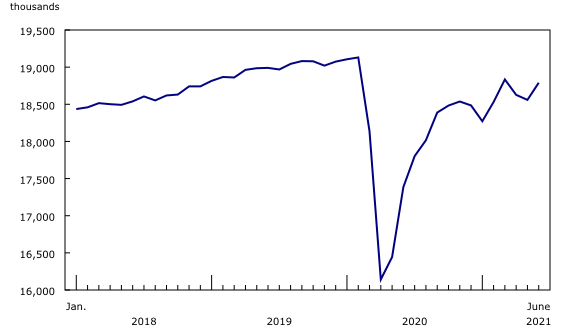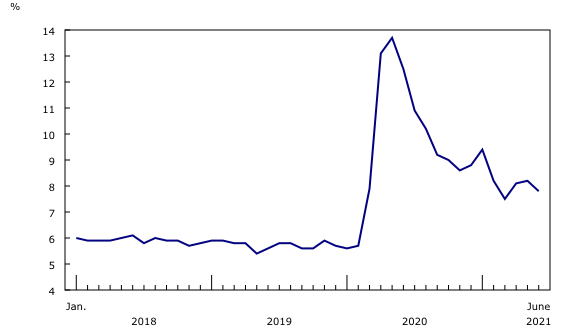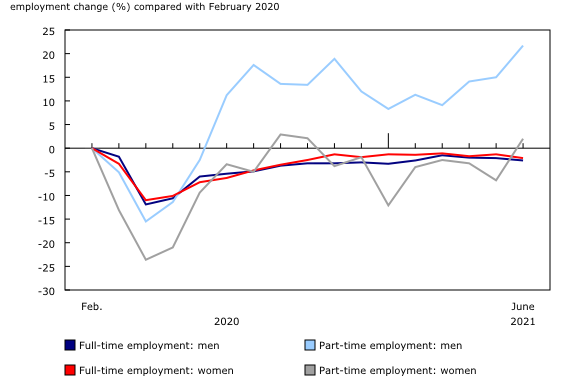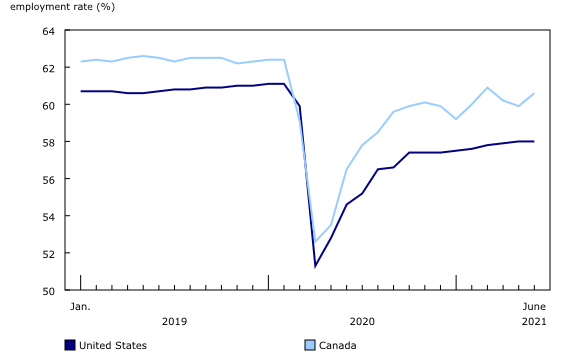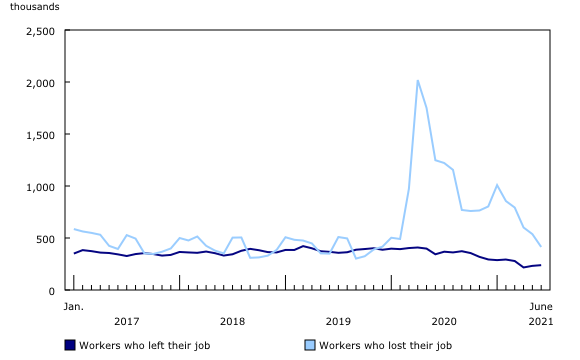Labour Force Survey, June 2021
Archived Content
Information identified as archived is provided for reference, research or recordkeeping purposes. It is not subject to the Government of Canada Web Standards and has not been altered or updated since it was archived. Please "contact us" to request a format other than those available.
Released: 2021-07-09
June Labour Force Survey (LFS) data reflect labour market conditions during the week of June 13 to 19.
Compared with the May reference week, public health restrictions had been significantly eased in several jurisdictions by the end of the June reference week. Most indoor and outdoor dining, recreation and cultural activities, retail shopping, and personal care services had resumed or continued in eight provinces, with varying degrees of capacity restrictions.
Ontario's stay-at-home order was lifted on June 2, and outdoor dining and some in-person non-essential shopping resumed on June 11. However, indoor dining and gyms, as well as personal care services, remained closed during the reference week. Remote schooling continued across the province.
Manitoba remained under tight public health restrictions, including the closure of restaurants and bars, personal care services, and recreation and cultural facilities. Remote schooling continued for large parts of the province.
Highlights
Employment rebounds in June
Employment rose by 231,000 (+1.2%) in June, following a cumulative decline of 275,000 over the previous two months.
Employment growth was entirely in part-time work and concentrated among youth aged 15 to 24.
After falling by 143,000 over the previous two months, full-time work was little changed.
The number of employed people working less than half their usual hours fell by 276,000 (-19.3%).
The number of self-employed workers fell by 63,000 (-2.3%); down 7.2% compared with February 2020.
In the three months ending in June, the employment rate for Indigenous people was 55.8%, little changed from February 2020 (56.2%) (not seasonally adjusted).
Total hours worked were little changed and were 4.0% below their pre-pandemic level.
The number of Canadians working from home fell by nearly 400,000 to 4.7 million.
Employment increased in Ontario, Quebec, British Columbia and Nova Scotia.
Unemployment rate falls while the labour force expands
The unemployment rate was 7.8%, as the total number of unemployed Canadians fell by 61,000 (-3.7%).
The number of people in the labour force—either employed or unemployed—increased by 170,000 (+0.8%).
The labour force participation rate increased 0.6 percentage points to 65.2%.
The unemployment rate among visible minority Canadians aged 15 to 69 fell 1.3 percentage points to 10.1% (not seasonally adjusted).
Youth employment grows as public health restrictions are eased
Employment among youth aged 15 to 24 rose by 164,000 (+7.1%), the largest single-month increase for this age group since July 2020.
The number of unemployed youth aged 15 to 24 fell by 50,000, with declines among both young women and young men.
In June, the employment rate for returning students aged 20 to 24 was 67.5%, up from 51.0% in May.
Employment rises in several industries providing in-person services
The number of people working in accommodation and food services rose by 101,000 (+11.8%).
In the accommodation and food services industry, workers earned an average of $17.35 per hour; the all-industry average was $29.70.
With restrictions on non-essential stores eased in many provinces, employment in retail trade rose by 75,000 (+3.4%).
The number of people working in goods-producing industries fell by 48,000, the second consecutive monthly decline.
Employment in the construction industry fell by 23,000 (-1.6%) and in natural resources by 9,800 (-2.9%).
Employment rebounds in June as some restrictions are lifted
Employment rose by 231,000 (+1.2%) in June, following a cumulative decline of 275,000 over the previous two months. The unemployment rate fell 0.4 percentage points to 7.8%.
Employment growth in June was entirely in part-time work and concentrated among youth aged 15 to 24, primarily young women. Increases were greatest in accommodation and food services and retail trade, consistent with the lifting or easing of public health restrictions affecting these industries in late May and early June in many jurisdictions.
The number of employed people working less than half their usual hours fell by 276,000 (-19.3%) in June. Total hours worked were little changed and were 4.0% below their pre-pandemic level.
Employment increase concentrated in part-time work
All of the employment increase in June was in part-time work, which rose by 264,000 (+8.0%) following combined losses of 132,000 over the previous two months. The overall level of part-time employment was essentially the same as in February 2020, prior to the COVID-19 pandemic. Increases in the month were driven by accommodation and food services, and retail trade—two industries where part-time workers represent an above-average proportion of employment—and were concentrated among youth.
After falling by 143,000 over the previous two months, full-time work was little changed in June, and was 336,000 (-2.2%) lower than its pre-pandemic level.
Gains driven by private sector employees, while self-employment declines
The number of private sector employees rose by 251,000 (+2.1%) in June, following two monthly declines. As of June, the number of private sector employees was 2.5% lower (-313,000) than in February 2020.
In the public sector, employment rose by 43,000 (+1.1%) in June, bringing it to 180,000 (+4.6%) above pre-pandemic levels. Employment in this sector has trended up following the initial wave of the pandemic, particularly driven by increases in health care and social assistance, public administration, and educational services.
The number of self-employed workers fell by 63,000 (-2.3%) in June and was down 7.2% (-207,000) compared with February 2020. Self-employment is a broad category which includes workers in a range of situations, including working owners of incorporated or unincorporated businesses, and independent contractors. Compared with June 2019, declines in the number of self-employed were widespread across multiple industries, and were concentrated among the self-employed with paid help.
Employment rate remains below pre-pandemic levels
To fully understand current and emerging labour market trends, it is essential to consider employment change against the backdrop of population change, which totalled 1.1% (+334,000) between February 2020 and June 2021. In order to keep pace with this population growth and maintain a stable employment rate—that is, employment as a proportion of the population aged 15 and over—employment would have had to grow by 203,000. Instead, total employment was 340,000 lower in June than in February 2020 and the employment rate was 1.7 percentage points lower (60.1% compared with 61.8%)
Growth in sales and service occupations contributes to employment gains for Chinese and Filipino Canadians
Employment increased by 41,000 among Chinese Canadians and by 31,000 among Filipino Canadians in June, driven in part by increased employment in sales and service occupations (not seasonally adjusted). This occupational category, which accounted for most of the overall employment increase in June, represents a larger share of employment among Chinese and Filipino Canadians than the national average.
Among Black Canadians, employment increased by 53,000 in June, driven by increases in trades, transport and equipment operators and related occupations (+37,000), and sales and service occupations (+24,000) (not seasonally adjusted).
Number of Canadians who worked from home drops by nearly 400,000
Among Canadians who worked at least half their usual hours in June, the number who worked from home fell by nearly 400,000 to 4.7 million. For 2.6 million of these people, working from home represented an adaptation to the COVID-19 pandemic, as this was not their usual work location. At the same time, the number of people working at locations other than home rose by approximately 700,000 to 12.3 million.
Almost one-third (31.4%) of workers aged 25 to 54 and more than one-quarter (27.2%) of those aged 55 and older worked from home in June. Due in part to their concentration in industries where working from home is less feasible, such as accommodation and food services, a far smaller proportion of youth aged 15 to 24 (12.9%) did so.
Unemployment rate falls while the labour force expands
The unemployment rate fell 0.4 percentage points to 7.8% in June, as the total number of unemployed Canadians fell by 61,000 (-3.7%). The unemployment rate remained above the post-pandemic low of 7.5% recorded in March 2021 but was considerably lower than the recent peak of 9.4% in January 2021 and the record high of 13.7% in May 2020.
Long-term unemployment—the number of people unemployed for 27 weeks or more—was little changed in June and was 298,000 (+166.0%) higher than in February 2020.
The total size of the labour force—the total number of people who are either employed or unemployed—increased by 170,000 (+0.8%) in June. After dipping the previous two months, the labour force participation rate (the labour force as a proportion of the population aged 15 and older) increased 0.6 percentage points to 65.2%.
Unemployment rate falls in many population groups designated as visible minorities
Among Canadians aged 15 to 69 who belong to population groups designated as visible minorities, the unemployment rate fell 1.3 percentage points to 10.1% in June (not seasonally adjusted). This compares with a decline in the unemployment rate of 0.9 percentage points among Canadians who were not Indigenous or a visible minority, to 6.1%.
Declines occurred among Southeast Asian (-3.9 percentage points to 8.3%), Filipino (-3.0 percentage points to 7.0%), Black (-2.6 percentage points to 9.4%), and Chinese Canadians (-2.1 percentage points to 10.2%) (not seasonally adjusted). In contrast, the unemployment rate rose 1.4 percentage points to 12.2% among South Asian Canadians in June (not seasonally adjusted).
All indicators of labour market underutilization decline
The labour underutilization rate—which complements the unemployment rate by capturing a broader range of people who are available and want to work—declined 2.0 percentage points to 15.6% in June. All components of the underutilization rate dropped, led by a decrease of 276,000 (-19.3%) in the number of people who were employed but who worked less than half their usual hours. Compared with one month earlier, there were 58,000 (-10.1%) fewer people in June who were not in the labour force but wanted work.
Despite these decreases, all components of the underutilization rate remained higher than in February 2020, including those who were employed but worked less than half their usual hours (+341,000; +42.0%); job searchers (+347,000; +33.3%); those on temporary layoff or with arrangements to start a job in the near future (+99,000; +94.3%); and those who wanted a job but who did not look for one (+120,000; +30.2%).
Youth employment grows as public health restrictions are eased
Employment among youth aged 15 to 24 rose by 164,000 (+7.1%) in June, the largest single-month increase for this age group since July 2020. Gains were shared between teens aged 15 to 19 (+89,000; +11.4%) and young women aged 20 to 24 (+72,000; +10.1%), with little change among young men aged 20 to 24.
Compared with February 2020, employment was down by a similar proportion for young women aged 15 to 24 (-72,000; -5.6%) and young men of the same age (-54,000; -4.1%). From November 2020 to May 2021, employment was further from pre-COVID levels for young women than for young men.
The number of unemployed youth aged 15 to 24 fell by 50,000 in June, with declines among both young women and young men. The unemployment rate for young women aged 15 to 24 fell 3.1 percentage points to 12.7%, the lowest rate since the start of the pandemic but 3.7 percentage points above the February 2020 rate. Among young men, the unemployment rate fell 1.7 percentage points to 14.4%, similar to the rate in March 2021 and 2.6 percentage points higher than in February 2020.
The June decline in the unemployment rate was more than twice as large among youth in population groups designated as visible minorities (-7.0 percentage points, not seasonally adjusted) than among non-visible minority youth (-2.7 percentage points). Despite the larger decline, the unemployment rate remained higher in June for visible minority youth (17.8%) than for youth who are not members of a visible minority group (12.2%) (not seasonally adjusted).
Youth labour force participation increased by 114,000 (+4.1%) in June, and the participation rates of both young women (64.6%) and young men (64.1%) were on par with pre-COVID February 2020 levels.
Labour market conditions improve for students
During the summer months, the Labour Force Survey captures labour market information for youth who were full-time students in March and intend to return to school in September. This information helps to shed light on the experiences of students seeking to earn work experience and to fund their education.
In May 2021, returning students aged 20 to 24 faced challenging labour market conditions, reflected in the fact that their employment rate (51.0%) was nearly 10 percentage points below the average for the month of May from 2014 to 2019 (60.8%). By the June LFS reference week, the employment rate for this group had increased to 67.5%, roughly equivalent to the historical average for June (68.0%). Gains among female students in this age group were stronger (+18.9 percentage points to 69.2%) than among their male counterparts (+13.4 percentage points to 65.4%). Among both sexes, most of the improvement in the employment rate was due to employment gains in industries which typically account for a large portion of student employment—retail trade, accommodation and food services, and information, culture and recreation—and for which public health restrictions have recently been lifted or eased.
The unemployment rate among returning students aged 20 to 24 was 11.5% in June, 1.7 percentage points higher than the 2014-to-2019 June average (9.8%). In comparison, in May the unemployment rate for this group (24.1%) was 11.1 percentage points higher than the pre-pandemic May average (13.0%).
For core-age population, part-time employment gains partially offset by full-time losses
Overall employment for people in the core working age group of 25 to 54 rose by 45,000 (+0.4%) in June. Employment for this group was 162,000 below (-1.3%) pre-COVID levels, with similar deficits for men (-80,000; -1.2%) and women (-82,000; -1.4%).
In June, overall employment among core-aged women rose by 48,000 (+0.8%), as part-time gains (+89,000; +9.4%) exceeded full-time losses (-41,000; -0.8%).
Employment for core-aged men held steady in June; with full-time employment decreasing (-27,000; -0.4%) and part-time work increasing (+24,000; +5.9%). Part-time employment for core-aged men, which has been consistently above pre-pandemic levels since July 2020, was 77,000 (+21.7%) higher in June than in February 2020. While part-time employment continued to account for a relatively small share (6.8%) of all employment for core-aged men in June, nearly all of the increase in part-time work since June 2019 has been among those who wanted full-time hours (30 hours or more per week) but could not find them (not seasonally adjusted). Much of the increase in part-time employment for core-aged men since June 2019 has been in the construction, manufacturing and transportation and warehousing industries (not seasonally adjusted).
The labour force participation rate was little changed in June among both core-aged men (91.5%) and women (83.2%). The rate for men was 0.5 percentage points higher than in February 2020, while for women in this age group it was down 0.4 percentage points from its pre-pandemic level.
Employment rises for women aged 55 and older
Employment among women aged 55 and older rose by 26,000 (+1.4%) in June, with most of the increase in Ontario. The unemployment rate for this group was 8.5%, little changed from May but 3.5 percentage points higher than in February 2020. Employment for women aged 55 and older, which reached pre-pandemic levels in March before falling in April and May, was 35,000 (-1.9%) lower in June than in February 2020.
Among men aged 55 and older, employment held steady for the third consecutive month after reaching pre-pandemic levels in March. Unemployment rose by 17,000 (+9.4%) in June, with much of the increase attributable to temporary layoffs. The unemployment rate for men aged 55 and older rose 0.7 percentage points to 8.1%, the highest rate since January 2021 and 2.8 percentage points higher than February 2020.
Employment rate for very recent immigrants increases as their population continues to fall
The number of newcomers to Canada continues to fall to record lows due to the pandemic-related travel restrictions. In the three months ending in June 2021, the population of immigrants landing within the previous five years was down 11.7% compared with the pre-pandemic level of February 2020 (three-month moving average, not seasonally adjusted). Over the same period, employment for this group was down 6.5%. As a result of their population falling more than their employment, the employment rate for very recent immigrants continued its upward trend, reaching 67.7% in June, up 3.7 percentage points compared with February 2020.
On the other hand, the employment rate in June among immigrants in Canada for more than five years (57.8%) was down 1.9 percentage points compared with February 2020, while the rate among people born in Canada (60.3%) was down 1.1 percentage points over the same period (three-month moving average, not seasonally adjusted).
Employment rate for Indigenous people approaches pre-pandemic level
LFS information for Indigenous people reflects the experience of those who identify as First Nations, Métis, or Inuit, and who live off-reserve in the provinces.
In the three months ending in June, the employment rate for Indigenous people was 55.8%, little changed from the pre-pandemic rate of 56.2% observed in February 2020. At the same time, the employment rate for the non-Indigenous population was 60.1% in June, down 1.1 percentage points from February 2020 (three-month moving average, not seasonally adjusted).
Employment rises in several industries providing in-person services
Employment rose markedly in June in several services-producing industries where a high proportion of jobs involve face-to-face interactions with the public, including accommodation and food services (+101,000), retail trade (+75,000), and "other" services (+24,000).
Employment also rose in educational services (+26,000), health care and social assistance (+21,000), professional, scientific and technical services (+18,000), as well as business, building and other support services (+18,000).
Overall, the number of people working in services-producing industries grew by 279,000, the largest increase since March 2021.
In contrast, the number of people working in goods-producing industries fell by 48,000 in June, the second consecutive monthly decline.
Largest employment increase in accommodation and food services since July 2020
The number of people working in accommodation and food services rose by 101,000 (+11.8%) in June, with Quebec, Alberta and British Columbia accounting for most of the increase. Employment in the industry grew more slowly in Ontario (+16,000; +4.7%), where restrictions on indoor dining remained in place during the June LFS reference week.
June employment gains brought the accommodation and food services industry to within 21.6% (-263,000) of its pre-COVID employment level, the smallest gap since November 2020. Nevertheless, the industry continues to account for the majority (77.4%) of the overall difference between current and February 2020 employment.
Across all industries, average wages were $29.70 per hour in June, up 7.1% compared with June 2019. As the easing and lifting of public health restrictions continues in the coming months—and as employers in industries hardest hit by the COVID-19 pandemic seek to return to full business operations—changes in wage levels within industries will be an important indicator of the short-term balance between labour supply and demand.
In the accommodation and food services industry, workers earned an average of $17.35 per hour in June, up 6.2% compared with two years earlier. Much of this increase was driven by occupations in management, business, finance and administration. For the majority of employees in the industry who belong to the broad sales and service occupational group, average wages were up 2.8% (+$0.44 to $16.07) in June 2021 compared with June 2019. Wage increases were larger in some specific occupations, including cooks, whose average wages increased 6.2% (+$0.94 to $16.06) and food counter attendants and kitchen helpers, who saw a 6.0% increase (+$0.85 to $14.95). Among food and beverage servers, the average hourly wage was $17.18 per hour, little changed from two years earlier.
More people working in retail trade
With restrictions on non-essential stores eased in many provinces, employment in retail trade rose by 75,000 (+3.4%) in June. The increase erased most of the losses of April and May, but the number of people working in the industry remained 2.9% (-65,000) below pre-COVID levels.
Despite job losses in April and May, the number of vacancies in the retail trade industry has remained relatively high. According to monthly data from the Job Vacancy and Wage Survey, retail trade (80,000) was second only to the health care and social assistance industry (96,000) in April in terms of total job vacancies (not seasonally adjusted). At the same time, retail trade accounted for a larger share (15.5%) of recently unemployed workers than any other industry (not seasonally adjusted). Among people who were unemployed but last worked during the previous 12 months, 105,000 were previously employed in retail trade (not seasonally adjusted) in June. This pool of workers with previous experience in retail trade may help businesses find qualified employees as the economy continues to reopen in the months ahead.
Average wages for sales and service workers in retail trade were up 5.1% in June compared with two years earlier (+$0.84 to $17.40), including increases of 5.4% among retail salespersons (+$0.89 to $17.26) and 4.7% among cashiers (+$0.66 to $14.70).
Employment grows in "other services"
Employment rose by 24,000 (+3.3%) in "other services," an industry which includes subsectors such as personal and laundry services which were affected by the introduction or tightening of public health restrictions in April and May.
With this increase, the number of people working in the industry returned to its April 2021 level, but remained 7.5% (-61,000) below its February 2020 level.
Smaller gains in several services-producing industries
In June, employment also increased in educational services (+26,000; +1.8%), health care and social assistance (+21,000; +0.8%), and professional, scientific and technical services (+18,000; +1.1%). The increase in health care and social assistance brought employment in the industry above pre-COVID levels for the first time (+42,000; +1.7%).
The number of people working in business, building and other support services increased for the first time since August 2020 (+18,000; +2.6%), with employment returning to within 5.5% (-42,000) of the level recorded before the pandemic in February 2020.
In contrast, there were 17,000 (-1.8%) fewer people working in transportation and warehousing, mostly as a result of losses in Ontario and Alberta. The decline largely offset the gain in May, and employment fell to 5.7% (-59,000) below pre-COVID levels.
Employment falls for the second consecutive month in the goods-producing sector
Total employment in good-producing industries declined by 48,000 (-1.2%) in June, bringing quarterly losses to 106,000.
Employment in the construction industry fell by 23,000 (-1.6%) in June, with losses concentrated in Alberta and British Columbia. Nationally, most of the drop was attributable to a decline in the number of self-employed workers in the sector. The overall number of people working in construction fell to its lowest level since January 2021 and was 78,000 below pre-COVID levels.
Employment also declined in natural resources (-9,800; -2.9%) in June, with Quebec and British Columbia accounting for most of the decrease. Despite the drop, employment in the industry remained above pre-COVID levels (+19,000; +6.2%).
Employment up in four provinces
Employment increased in June in the nation's three largest provinces—Ontario, Quebec, and British Columbia—and in Nova Scotia. In contrast, employment declined in Saskatchewan, Manitoba and Prince Edward Island. There was little change in New Brunswick, Newfoundland and Labrador, and Alberta.
Compared with the February 2020 pre-pandemic level, the employment gap was largest in Prince Edward Island (-4.9%), followed by Saskatchewan (-2.8%), Manitoba (-2.5%) and Ontario (-2.5%). In contrast, British Columbia was the lone province with employment above its pre-pandemic level.
For further information on key province and industry level labour market indicators, see "Labour Force Survey in brief: Interactive app."
Following two months of losses, employment in Ontario rose by 117,000 (+1.6%) in June, as strict public health measures began to ease. Employment gains were mostly among youth and in part-time work. The largest increase was in retail trade, while gains also occurred in professional, scientific and technical services as well as accommodation and food services. The unemployment rate fell 0.9 percentage points to 8.4%. In the Toronto census metropolitan area (CMA), employment rose by 90,000 (+2.8%), the first increase since March 2021.
Bolstered by the easing of public health measures and the lifting of curfews, employment in Quebec rose by 72,000 (+1.7%) in June, the first increase since March 2021. Employment was up mostly among youth, and the largest increase was in accommodation and food services. The unemployment rate for the province was little changed at 6.3%. In the Montréal CMA, where tighter public health measures have been eased more gradually, employment rose by 55,000 (+2.5%), the first increase since February 2021.
In British Columbia, employment rose by 42,000 (+1.6%), the first increase since March 2021. Employment rose in part-time work, mostly among young people aged 15 to 24. Gains were led by accommodation and food services, followed by health care and social assistance. The unemployment rate stood at 6.6% in June, the second lowest in the country, after Quebec. In the Vancouver CMA, employment increased by 22,000 (+1.5%).
Following a decline of 22,000 in May, employment in Nova Scotia rebounded by 14,000 (+3.1%) in June. Gains impacted most major demographic groups, and were all in part-time work. Industry employment gains were broad-based, with the largest in retail trade. The unemployment rate in Nova Scotia, which emerged from a province-wide lockdown on June 2, dropped 0.8 percentage points to 9.0%.
In June, there were 6,400 (-1.0%) fewer employed Manitobans and the unemployment rate in the province rose to 7.6% (+0.4 percentage points). Manitoba has been in the critical (red) level of the Pandemic Response System for the past seven months.
In June, there were also fewer employed people in Saskatchewan (-6,500; -1.2%) while the unemployment rate was little changed at 6.7%. In Prince Edward Island, employment fell (-1,400; -1.8%) and the unemployment rate rose 2.9 percentage points to 12.5%.
Fewer people employed in Yukon
The Labour Force Survey publishes labour market data for the territories in the form of three-month moving averages.
After an increase in the fourth quarter of 2020 and little change in the first quarter of 2021, employment in Yukon declined by 500 in the three months ending in June. The employment rate decreased 1.9 percentage points to 66.9%. The unemployment rate was little changed at 6.8%.
In the Northwest Territories, employment edged up by 400, the third consecutive quarterly increase. The unemployment rate fell by 2.0 percentage points to 4.4%, while the employment rate rose 1.4 percentage points to 69.9%.
Employment in Nunavut held steady for the third consecutive quarter. With fewer people looking for work, the unemployment rate fell from 7.5% in the first quarter to 3.5% in the second quarter. The labour force participation rate fell 2.9 percentage points to 50.1% in the three months ending in June.
Employment rate remains higher in Canada than in the United States
While international comparisons of the pandemic impact on labour markets are challenging due to differences in concepts, survey design and reference periods, comparisons between the labour market situation in Canada and in the United States can be made by adjusting Canadian data to U.S. concepts. For more information, see "Measuring Employment and Unemployment in Canada and the United States – A comparison."
A frequent point of comparison between Canada and the U.S. is the employment rate, defined as the number of people who are employed as a percentage of the working-age population, which is typically higher in Canada. Adjusted to U.S. concepts, and for the population aged 16 and older, the employment rate was 60.6% in Canada and 58.0% in the U.S. in June. The rate was down 1.8 percentage points from February 2020 in Canada, compared with a drop of 3.1 percentage points in the United States.
The unemployment rate, adjusted to US concepts, was 6.3% in Canada in June, 0.4 percentage points higher than in the United States (5.9%). The rate was 1.7 percentage points higher than in February 2020 in Canada, while in the United States it was 2.4 percentage points higher.
The labour force participation rate, also adjusted to U.S. concepts, was 64.7% in Canada in June, down 0.7 percentage points from February 2020. In the United States, the participation rate was 61.6%, 1.7 percentage points lower than in February 2020.
Looking ahead
While the number of core-aged workers losing a job reached unprecedented highs during the COVID-19 pandemic, the number choosing to leave a job voluntarily has trended down slightly. It is unsurprising that labour market uncertainty—such as that experienced over the past 15 months—would reduce the number of people willing to take the risks associated with changing jobs or leaving employment altogether. In addition, some Canadians may have delayed major life changes, such as relocation or retirement, due to limitations on travel and other activities.
In the coming months, the further easing of public health restrictions is likely to result in a continuing re-opening of the economy and the resumption of business activities. These changes, by creating new opportunities for both workers and employers, could be expected to result in an increase in the level of labour market churn, or the number of workers becoming newly employed, changing jobs or leaving the labour force to pursue other interests.
As of June, key measures of labour market churn indicate that the effect of these increased opportunities have not yet been felt. For example, the number of people aged 25 to 54 years old who had left employment voluntarily within the previous 12 months—and remained either unemployed or out of the labour market—was 128,000 (-34.9%) lower than two years earlier. In addition, among the population 55 and older who had voluntarily left a job in the last 12 months and remained not employed, 2.1% had cited "retirement" as their main reason, essentially unchanged from 2.4% in June 2019.
The Labour Force Survey will continue to use a wide range of standard and supplementary indicators of labour market conditions to inform Canadians on the ongoing economic and social transformations resulting from the COVID-19 pandemic.
Sustainable Development Goals
On January 1, 2016, the world officially began implementation of the 2030 Agenda for Sustainable Development—the United Nations' transformative plan of action that addresses urgent global challenges over the next 15 years. The plan is based on 17 specific sustainable development goals.
The Labour Force Survey is an example of how Statistics Canada supports the reporting on the Global Goals for Sustainable Development. This release will be used in helping to measure the following goals:


Note to readers
The Labour Force Survey (LFS) estimates for June are for the week of June 13 to 19.
The LFS estimates are based on a sample and are therefore subject to sampling variability. As a result, monthly estimates will show more variability than trends observed over longer time periods. For more information, see "Interpreting Monthly Changes in Employment from the Labour Force Survey."
This analysis focuses on differences between estimates that are statistically significant at the 68% confidence level.
LFS estimates at the Canada level do not include the territories.
The LFS estimates are the first in a series of labour market indicators released by Statistics Canada, which includes indicators from programs such as the Survey of Employment, Payrolls and Hours (SEPH); Employment Insurance Statistics; and the Job Vacancy and Wage Survey. For more information on the conceptual differences between employment measures from the LFS and those from the SEPH, refer to section 8 of the Guide to the Labour Force Survey (71-543-G).
Since March 2020, all face-to-face interviews have been replaced by telephone interviews to protect the health of both interviewers and respondents. In addition, all telephone interviews were conducted by interviewers working from their home and none were done from Statistics Canada's call centres. Close to 41,000 interviews were completed in June.
The distribution of LFS interviews in June 2021 compared with May 2021, was as follows:
Telephone interviews – from interviewer homes
• May 2021: 64.9%
• June 2021: 64.2%
Online interviews
• May 2021: 35.1%
• June 2021: 35.8%
The employment rate is the number of employed people as a percentage of the population aged 15 and older. The rate for a particular group (for example, youths aged 15 to 24) is the number employed in that group as a percentage of the population for that group.
The unemployment rate is the number of unemployed people as a percentage of the labour force (employed and unemployed).
The participation rate is the number of employed and unemployed people as a percentage of the population aged 15 and older.
Full-time employment consists of persons who usually work 30 hours or more per week at their main or only job.
Part-time employment consists of persons who usually work less than 30 hours per week at their main or only job.
Total hours worked refers to the number of hours actually worked at the main job by the respondent during the reference week, including paid and unpaid hours. These hours reflect temporary decreases or increases in work hours (for example, hours lost due to illness, vacation, holidays or weather; or more hours worked due to overtime).
In general, month-to-month or year-to-year changes in the number of people employed in an age group reflect the net effect of two factors: (1) the number of people who changed employment status between reference periods, and (2) the number of employed people who entered or left the age group (including through aging, death or migration) between reference periods.
Supplementary indicators used in June 2021 analysis
Employed, worked zero hours includes employees and self-employed who were absent from work all week, but excludes people who have been away for reasons such as 'vacation,' 'maternity,' 'seasonal business,' and 'labour dispute.'
Employed, worked less than half of their usual hours includes both employees and self-employed, where only employees were asked to provide a reason for the absence. This excludes reasons for absence such as 'vacation,' 'labour dispute,' 'maternity,' 'holiday,' and 'weather.' Also excludes those who were away all week.
Not in labour force but wanted work includes persons who were neither employed, nor unemployed during the reference period and wanted work, but did not search for reasons such as 'waiting for recall (to former job),' 'waiting for replies from employers,' 'believes no work available (in area, or suited to skills),' 'long-term future start,' and 'other.'
Unemployed, job searchers were without work, but had looked for work in the past four weeks ending with the reference period and were available for work.
Unemployed, temporary layoff or future starts were on temporary layoff due to business conditions, with an expectation of recall, and were available for work; or were without work, but had a job to start within four weeks from the reference period and were available for work (don't need to have looked for work during the four weeks ending with the reference week).
Labour underutilization rate (specific definition to measure the COVID-19 impact) combines all those who were unemployed with those who were not in the labour force but wanted a job and did not look for one; as well as those who remained employed but lost all or the majority of their usual work hours for reasons likely related to COVID-19 as a proportion of the potential labour force.
Potential labour force (specific definition to measure the COVID-19 impact) includes people in the labour force (all employed and unemployed people), and people not in the labour force who wanted a job but didn't search for reasons such as 'waiting for recall (to former job),' 'waiting for replies from employers,' 'believes no work available (in area, or suited to skills),' 'long-term future start,' and 'other.'
Information on population groups
Beginning in July 2020, the LFS includes a question asking respondents to report the population group(s) to which they belong. Possible responses, which are the same as in the 2021 Census, include:
• White
• South Asian e.g., East Indian, Pakistani, Sri Lankan
• Chinese
• Black
• Filipino
• Arab
• Latin American
• Southeast Asian e.g., Vietnamese, Cambodian, Laotian, Thai
• West Asian e.g., Iranian, Afghan
• Korean
• Japanese
• Other
According to the Employment Equity Act, visible minorities are "persons, other than Aboriginal peoples, who are non-Caucasian in race or non-white in colour." In the text, people who identify as a member of a population group (visible minority) are analyzed separately.
Seasonal adjustment
Unless otherwise stated, this release presents seasonally adjusted estimates, which facilitate comparisons by removing the effects of seasonal variations. For more information on seasonal adjustment, see Seasonally adjusted data – Frequently asked questions.
The seasonally adjusted data for retail trade and wholesale trade industries presented here are not published in other public LFS tables. A seasonally adjusted series is published for the combined industry classification (wholesale and retail trade).
Next release
The next release of the LFS will be on August 6, 2021. July data will reflect labour market conditions during the week of July 11 to 17.
Products
More information about the concepts and use of the Labour Force Survey is available online in the Guide to the Labour Force Survey (71-543-G).
The product "Labour Force Survey in brief: Interactive app" (14200001) is also available. This interactive visualization application provides seasonally adjusted estimates by province, sex, age group and industry.
The product "Labour Market Indicators, by province and census metropolitan area, seasonally adjusted" (71-607-X) is also available. This interactive dashboard provides customizable access to key labour market indicators.
The product "Labour Market Indicators, by province, territory and economic region, unadjusted for seasonality" (71-607-X) is also available. This dynamic web application provides access to labour market indicators for Canada, province, territory and economic region.
The product Labour Force Survey: Public Use Microdata File (71M0001X) is also available. This public use microdata file contains non-aggregated data for a wide variety of variables collected from the Labour Force Survey. The data have been modified to ensure that no individual or business is directly or indirectly identified. This product is for users who prefer to do their own analysis by focusing on specific subgroups in the population or by cross-classifying variables that are not in our catalogued products.
Contact information
For more information, or to enquire about the concepts, methods or data quality of this release, contact us (toll-free 1-800-263-1136; 514-283-8300; STATCAN.infostats-infostats.STATCAN@canada.ca) or Media Relations (613-951-4636; STATCAN.mediahotline-ligneinfomedias.STATCAN@canada.ca).
- Date modified:




